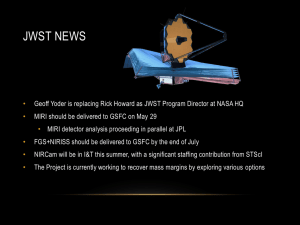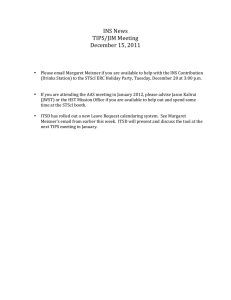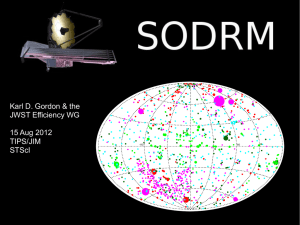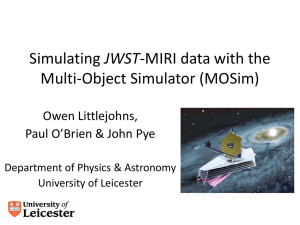Calibration Plans for the Mid Infrared Instrument (MIRI) on JWST James Rhoads
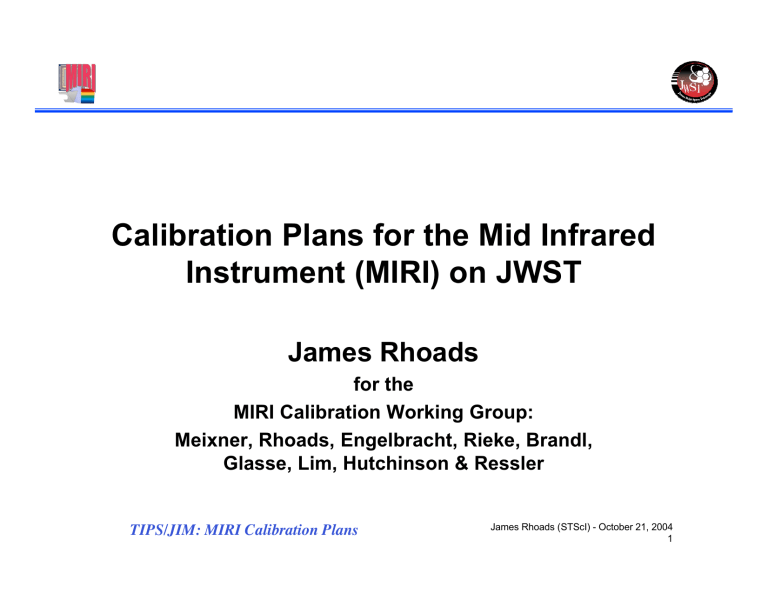
Calibration Plans for the Mid Infrared
Instrument (MIRI) on JWST
James Rhoads
for the
MIRI Calibration Working Group:
Meixner, Rhoads, Engelbracht, Rieke, Brandl,
Glasse, Lim, Hutchinson & Ressler
TIPS/JIM: MIRI Calibration Plans James Rhoads (STScI) - October 21, 2004
1
Scope and Context of Presentation
MIRI Calibration Planning is under way.
This is a “midstream” presentation to
• Summarize planning effort so far;
• Solicit expert input from the STScI community;
• Incorporate experience from other instruments in
MIRI calibration planning.
TIPS/JIM: MIRI Calibration Plans James Rhoads (STScI) - October 21, 2004
2
MIRI Calibration Context and Status
We are “midstream” in MIRI calibration planning.
Four documents outline plans:
• MIRI Calibration Requirements Document;
• MIRI Calibration Plan (Overview and routine onorbit calibrations)
• MIRI Performance Test Specification (Ground testing)
• MIRI Commissioning Plan (On-orbit checkout)
So far, drafts exist for three of these, and two are fairly mature.
The plans need to remain flexible at this early date.
TIPS/JIM: MIRI Calibration Plans James Rhoads (STScI) - October 21, 2004
3
Instrument Calibration
• STScI will coordinate the development of an integrated calibration plan by all the instruments
– I&T = PI responsibility
– Commissioning = PI responsibility
– Post-commissioning = STScI responsibility
• STScI benefits from HST experience
– Calibrations planned using the integrated planning tool
– Yearly cycles for calibration programs tied to TAC
• Calibration data will come from 4 sources:
1) science data
2) observations done in parallel with science observations
3) observing time dedicated to calibration
4) ground testing calibration files
TIPS/JIM: MIRI Calibration Plans James Rhoads (STScI) - October 21, 2004
4
MIRI has four Science Modes
1. Photometric Imaging
2. Low Resolution Spectroscopy
3. Coronagraphy
TIPS/JIM: MIRI Calibration Plans
James Rhoads (STScI) - October 21, 2004
5
MIRI has four Science Modes
4. Integral Field Unit Spectroscopy
TIPS/JIM: MIRI Calibration Plans
James Rhoads (STScI) - October 21, 2004
6
MIRI Calibration Requirements Document:
FRD Requirement Number FRD Requirement
2.2 Photometric Imaging
2.2.1 General Characteristics
2.2.1.1 Field of view The imager field of view shall have an area equivalent to at least 2.2 square arc minutes ´(6/D)
2
. The ratio of long to short side of the field shall be no greater than
2.2.1.2 Pixel scale
PSF at 7(TBR)µm
Test ID(s)
IMG-OPT-01
IMG-OPT-02
2.2.1.3 Spectral bands MIRI shall provide imaging from 5 to 27mm in a total of
12 passbands. Approximately 6 of these passbands shall be used for broad spectral energy distribution determination, with the remainder reserved for photometric identification of broad spectral featu
IMG-RAD-09
Rationale MTS Requirements On orbit checkout?
SODRM program ID
The FOV scan will go beyond the MIRI imager FOV edges, establishing FOV size and instrument offset
This test will establish the PSF size, the pixel size will then be determined relative to this.
Dedicated spectral passband measurement
MTS 513.02, MTS 522.01,
MTS 523.02, MTS 524.01,
MTS 524.02, MTS 524.05,
MTS 524.07
MTS 521.01, MTS 522.01,
MTS 524.06
MTS 541.01, MTS 542.02,
MTS 542.03
Yes
Yes
No
Monitor under SODRM
329
Monitor under SODRM
329
Monitor photometric color terms under
SODRM 325
TIPS/JIM: MIRI Calibration Plans
James Rhoads (STScI) - October 21, 2004
7
Calibration Philosophy Overview
• Consider a draft data reduction pipeline.
• Determine calibration files needed for pipeline.
• Decide how those files can be generated (in-orbit, commissioning, ground test, analysis).
• Look for “missing links” (beyond pipeline).
• Some guiding principles:
– No end-to-end test (Telescope+MIRI) possible before flight
– Stand-alone ground testing of MIRI is planned
– (Almost) all ground-test results will be verified on-orbit with celestial calibrators
– Some additional on-orbit tests will plug “gaps” in ground testing, too.
TIPS/JIM: MIRI Calibration Plans
James Rhoads (STScI) - October 21, 2004
8
MIRI Calibration Plan: MIRI Calibration Process: A
Data frame from
Multi-Accum
SlowMode
ID bad pixels
Bad Pixel Mask
Or Table
Library
Dark Frames
Subtract
Reference
Pixels and
Dark frames
Reference Pixel Data:
Reference pixels for rows
Reference output
Corrected single
Frame
TIPS/JIM: MIRI Calibration Plans James Rhoads (STScI) - October 21, 2004
9
Focal Plane Array Calibrations
Some calibration needs are same for all three FPAs in MIRI.
• Read noise (infer from short darks)
• Dark-bias frames
• Subarrays: Dedicated calibrations for subarrays
limit # supported.
• Latent image reduction through anneals
– Also helps with persistence due to CR hits.
– No associated calibration file.
TIPS/JIM: MIRI Calibration Plans James Rhoads (STScI) - October 21, 2004
10
MIRI Imager Calibration Process: B
Corrected
Individual
Frames from
One Integration
Nonlinearity Correction;
Up-the-Ramp Fitting
with Cosmic Ray
Rejection and
Saturation Flagging
Nonlinearity coefficient maps
Local background
Frames or
Library Sky frames
Background
Subtraction
Populate the
Header w/ diagnostics
Flux calibrated
Data frame,
Uncertainty frame,
Mask
TIPS/JIM: MIRI Calibration Plans
Flat Field frame
Absolute
Flux
Calibration
Flat fields:
Pixel flat
Low Freq. Flat
Absolute
Flux
Conversion
Factors
James Rhoads (STScI) - October 21, 2004
11
MIRI Imager Calibration Process: C
Flux calibrated data frames at a dither position
Drizzle dither positions together into one mosaic
Source extraction & catalog generation
Gap free final image & catalogs
Offset files
TIPS/JIM: MIRI Calibration Plans James Rhoads (STScI) - October 21, 2004
12
MIRI Imager Calibration files
1. Bad pixel mask
2. Dark-bias frames
3. Short Dark frames (for Read noise and Bias measurements)
4. Library sky frames
5. Internal flat fields for high frequency variations
6. Sky flats and/or points of light flats for low frequency variations
7. Saturation counts map
8. Linearity counts map
9. Standard star measurements
10.Astrometric solutions file
TIPS/JIM: MIRI Calibration Plans James Rhoads (STScI) - October 21, 2004
13
MIRI coronagraphic calibration files
Coronagraphy: Add in
• Target acquisition image of target with neutral density filter
• Point spread function standard taken with the same corongraphic setup up and close in time to the science observation.
• Information on the location of the coronagraphic hole or center of the phase mask
Low Res Spectrograph: Add in
1. Wavelength calibration file
2. Location of the slit information on the FPA
Integral Field Unit: Add in
1. Table of slice and wavelength positions on the FPAs
2. Wavelength calibration spectra
TIPS/JIM: MIRI Calibration Plans James Rhoads (STScI) - October 21, 2004
14
Internal Calibration Unit
• Internal calibration source has hot filaments
(~800K, tunable) + concentrator (oblate spheroid,
10mm size) + relay optics.
• Calibration light feeds into pupil planes of both
IFU and imager at the central obscuration, using reflective optics.
• Redundant backup filament.
• In IFU, a third filament (lower intensity) will feed a wavelength calibration system.
• “Cheap” to use, but light does not pass through entire optical train.
TIPS/JIM: MIRI Calibration Plans James Rhoads (STScI) - October 21, 2004
15
Celestial calibrators
• Absolute flux calibration: use stars
~100 stars, may need Spitzer data for fainter MIRI appropriate standards
- used for flux, linearity, color
-may need ground based (VISIR) spectroscopy to check stellar atmosphere models of a few
- How do we choose stars w/o circumstellar dust? MIRI will be sensitive to this?
• Spectral calibrators: use PN in Mag. Clouds
• Astrometric standards: same clusters as NIRCam?
• Use telescope pointing for IFU?
TIPS/JIM: MIRI Calibration Plans James Rhoads (STScI) - October 21, 2004
16
In-orbit Internal Calibration Modes
1.
Dark Current + Bias
2.
Flat field calibration
3.
Wavelength calibration for the IFU spectrograph
4.
Wavelength Cal. For LRS?
5.
Read Noise Calibration
TIPS/JIM: MIRI Calibration Plans James Rhoads (STScI) - October 21, 2004
17
In orbit Monitoring Programs
•
321 Flat Field Monitoring for MIRI Imager
•
323 Dark Monitoring for MIRI Integral Field Unit (IFU) Spectrometer and Imager
•
325 Photometric Monitoring for MIRI Imager
•
329 Astrometric Monitoring for MIRI Imager
• 322 Flat Field Monitoring of the MIRI IFU
•
326 Spectrophotometric Monitoring of the MIRI IFU
•
324 Wavelength Calibration Monitoring for MIRI Integral Field Unit
(IFU) Spectrometer
•
327 Spectrophotometric Monitoring of the MIRI LRS
•
331 Wavelength Monitoring of the MIRI LRS
•
328 Coronagraph photometric monitoring
•
330 Coronagraph center location monitoring
TIPS/JIM: MIRI Calibration Plans
James Rhoads (STScI) - October 21, 2004
18
MIRI Coronagraphic Calibration Process: C
Flux calibrated
Data frames
PSF subtraction
From individual frames
Coronagraphic
Image of PSF standard
Position of object
Behind hole
Co-addition of several
PSF-subtracted frames at multiple roll angles
Final flux calibrated
High S/N
PSF subtracted
Coronagraphic image
TIPS/JIM: MIRI Calibration Plans
Target
Acquisition
Image and
Monitoring
Information
James Rhoads (STScI) - October 21, 2004
19
MIRI LRS Calibration Process: B
Corrected
Individual
Frames from
One Integration
Nonlinearity Correction;
Up-the-Ramp Fitting
with Cosmic Ray
Rejection and
Saturation Flagging
Nonlinearity coefficient maps
Local or library background frames;
Flat fields
Background subtract,
Flat field, and
Extract 2-D
LRS Spectrum
Absolute
Flux
Calibration
Absolute
Flux
Conversion
Factors
Wavelength
Calibration
Wavelength
Conversion
Factors
Populate the
Header w/ diagnostics
Flux calibrated
Data frame
Uncertainty frame
Mask
TIPS/JIM: MIRI Calibration Plans
James Rhoads (STScI) - October 21, 2004
20
MIRI LRS Calibration Process: C
Flux & wavelength
calibrated
2-D spectrum at a dither position
Drizzle dither
Positions together
Extract 1-D
Spectrum of
Source
Offset files
Gap free final
Spectrum
TIPS/JIM: MIRI Calibration Plans
James Rhoads (STScI) - October 21, 2004
21
MIRI IFU Calibration Process: B
Corrected
Individual
Frames from
One Integration
Nonlinearity Correction;
Up-the-Ramp Fitting
with Cosmic Ray
Rejection and
Saturation Flagging
Nonlinearity coefficient maps
Local or library background frames
Background subtraction
Populate the
Header w/ diagnostics
Wavelength calibration &
Data cube extraction
Flat fielding and
Absolute flux calibration
Mapping from x, y, and mode to
RA, Dec, _
Flat field frames and
Absolute flux conversion factors
Flux calibrated
Data frame
Uncertainty frame
Mask
TIPS/JIM: MIRI Calibration Plans
James Rhoads (STScI) - October 21, 2004
22
MIRI IFU Calibration Process: C
Flux & wavelength
calibrated data cube at a dither position
Drizzle dither
Positions together
Offset files
Gap free final data cube
Extract 1D or
2D spectra,
Line images,
Spectral index maps, etc.
TIPS/JIM: MIRI Calibration Plans James Rhoads (STScI) - October 21, 2004
23
MIRI Calibration Plan
PROGRAM NO.: 321
AS-OF DATE: 8 JUNE 2004
PROGRAM TITLE:
FLAT FIELD MONITORING FOR MIRI IMAGER
SYNOPSIS: WE PROPOSE TO MONITOR THE FLAT FIELDING STABILITY
OF THE MIRI IMAGER. WE ARE CONCERNED BOTH BY LONG AND BY
SHORT TERM EFFECTS IN THE TELESCOPE OR THE IMAGER. EVERY
WEEK WE PLAN TO TAKE TWO INTERNAL FLATS IN EACH OF THE SIX
BROAD BAND FILTERS. THREE TIMES A YEAR, WE WILL OBTAIN SKY
FLATS IN SIX BROAD BAND FILTERS. TWICE A YEAR WE WILL OBTAIN
INTERNAL FLATS IN ALL FILTERS. ONCE A YEAR WE WILL OBTAIN
SKY FLATS IN ALL THE FILTERS, THE CORONAGRAPH FILTERS AND
THE LOW RESOLUTION SPECTROGRAPH (LRS) PRISM.
SAMPLE AND SKY COVERAGE:
TWO LOCATIONS IN THE ZODICAL LIGHT: ONE HIGH BACKGROUND
AND ONE LOW BACKGROUND.
WE MAY WANT TO CONSIDER CHOOSING TWO SPECIFIC SPOTS IN THE
ZODIACAL BELT THAT ARE “IDEAL” FOR SUCH MEASUREMENTS. IF
THE SAME ARE USED THESE COULD DOUBLE AS THROUGHPUT
MEASUREMENTS.
Basis for exposure time estimates (needed S/N and brightnesses):
S/N ~1000
Sky flats: depends on zodiacal light background
Internal flats: ~10^14 photons/second => short 10 second exposures
INSTRUMENTS AND OBSERVING CONFIGURATIONS:
DETECTOR READOUT: FASTMODE AND SLOWMODE
SKY FLATS 3 TIMES A YEARS:
TIPS/JIM: MIRI Calibration Plans James Rhoads (STScI) - October 21, 2004
24
MIRI Performance Test Specification easure the PSF, to verify that the pixel size corresponds to ë/2D of the PSF at To measure the an
1. IMAGER TESTS
1.1 OPTICAL PERFORMANCE TESTS
1.1.1 IMG-OPT-01 FOV Measurement
Goal: To measure the imager FOV and to detect ghosts.
Outline: A point source is scanned across the entire imager array, nominally in a raster pattern.
This could either be done via discrete steps (several pixels) or via a continuous scan. As long as a sufficient row length and number of columns are chosen, the edge of the FOV will be found, i.e.
this will need a larger area than the FOV as the instrument may move in cool down. As the whole
FOV is being scanned, at various positions ghosts may be detected. The positions of these will be noted and IMG-OPT-02 will be used for follow up measurements.
Equipment Needed: A point source imaged on to the imager FOV via a telescope simulator, this will need to have a FOV scanning capability which goes beyond the nominal edge of the FOV.
Number of Pixels/Positions: This should be done at all relevant filter wheel positions.
How Often: Once per model
Open Issues : None
1.1.2 IMG-OPT-02 PSF Measurement
Goal: To m
7(TBR)µm and to characterise ghosts.
Outline: A point source is scanned in a fine spatial resolution raster pattern across an area sufficiently large to sample the PSF.
Equipment Needed: A stable point source, imaged on to the imager FOV via a telescope simulator
Number of Pixels/Positions: This should be done in several areas of the array, at least one position in the centre, one at each corner plus one at each edge. If necessary this type of test can also follow up ghost characterisation discovered by IM-OPT-01
How Often: Once per model
Open Issues : When we come to detailing the tests done, this test may be dropped if we consider that IMG-OPT-01 alone sufficiently samples the PSF.
1.1.3 IMG-OPT-03 Pupil Scanning
Goal: and sensitivity to sources near to the OTE primary mirror.
Outline: This test will scan the pupil plane both at the edge of the beam and beyond. If the pupil is scanned the edge of the beam gives a direct measurement of the angular extent of the beam.
Scanning the point source beyond the edge of the pupil then allows a measurement of out of field
(or external) stray light.
Equipment Needed: Ideally we would sample the pupil plane with a known point source in each cross-beam direction, finding the edges and characterising the external stray light on all sides of the beam. The edge of the beam should be fine sampled spatially in order to accurately determine the beam angular extent, while the out of field measurements can be more coarsely spaced.
Number of Pixels/Positions: The number of positions in the Pupil plane is TBD but there should be sufficient coverage to ensure the two goals of this test are met, if necessary, separately. All relevant filters should be tested.
How Often: Once per model
Open Issues: The MTS design may limit what this test is capable of. The out of field sampling is likely to be limited to several points on either one direction or two opposite directions. The in-pupil points at present do not have accurate photometric requirements. Although useful for alignment
TIPS/JIM: MIRI Calibration Plans James Rhoads (STScI) - October 21, 2004
25
